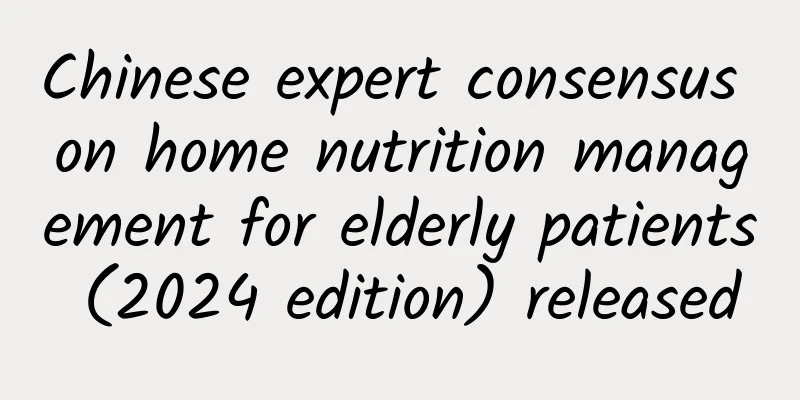Chinese expert consensus on home nutrition management for elderly patients (2024 edition) released

|
It has been 7 years since the release of the "Chinese Expert Consensus on Home Nutrition Management for Elderly Patients (2017 Edition)". With the publication of more research evidence and the development of home nutrition management practices, it is urgent to update the 2017 version of the consensus. This consensus update has formed a total of 35 recommendations or consensus opinions, which aim to guide grassroots professionals to provide scientific, reasonable and standardized home nutrition management services for the elderly at home or in the community. Background At the end of 2023, the national population aged 60 and above will be 296 million, of which 216 million will be aged 65 and above, accounting for 15.4% of the total population. It is estimated that around 2035, the number of elderly people aged 60 and above in my country will exceed 400 million, accounting for more than 30% of the total population, entering a stage of severe aging. The combined prevalence of malnutrition and malnutrition risk among elderly people in Chinese communities has reached 41.2%. Malnutrition is closely related to many adverse clinical outcomes. Domestic and foreign studies have shown that malnutrition has led to a 32% increase in the average annual number of hospitalizations for the elderly in my country, an increase of 486 yuan in annual hospitalization costs, and an increase of 45.84 billion yuan in treatment costs in my country in 2015, an increase in the rate of readmissions, and a 0.5% increase in the number of deaths. In 2017, the State Council issued the National Nutrition Plan 2017-2030, proposing to launch the "Nutrition Improvement Action for the Elderly" as one of the major actions. In 2022, the Office of the National Committee on Aging issued the Notice on Launching the Nutrition Improvement Action for the Elderly, pointing out that the key goals of the action are to enhance the nutrition and health awareness of the elderly, improve the nutrition and health status of the elderly, and enhance the nutrition and health service level of the health system for the elderly. Improving malnutrition in the elderly requires strong professional support and a long management cycle. The hospital stay is limited, and short-term nutritional management cannot achieve satisfactory results. Nutritional support needs to be extended outside the hospital to provide a full-course long-term nutritional management service for the elderly at home, in the community and in nursing homes, namely home nutrition management (HNA). Studies have shown that 71% of patients who undergo HNA continue to use HNA in the second year. There is a huge demand for HNA in China. An ongoing survey on the current status of HNA work in clinical nutrition departments of medical institutions across the country (currently involving more than 400 hospitals) shows that 37.98% of hospitals have carried out HNA, 87.97% of hospitals have established professional HNA information systems, 94.94% of hospitals have carried out family nutrition education before discharge, and 64.56% of hospitals have carried out active family nutrition follow-up after discharge. This shows that HNA in my country is gradually being promoted and developing steadily across the country. Guideline recommendations 01 HNA team and other support Recommendation 1 Establishing a multidisciplinary HNA team (members may include nutritionists, nurses, practicing physicians, rehabilitation therapists, psychotherapists, caregivers, etc.) to provide professional and comprehensive management may improve the nutritional status and quality of life of elderly patients, reduce complications, and help with rapid recovery. (Evidence level: Level 2, Recommendation level: Level B, Consensus rate: 100%) Recommendation 2 Improving the nutritional health knowledge and comprehensive care capabilities of HNA team members through education and training will help improve the nutritional status, physical and social functions of elderly patients. (Evidence level: Level 2, Recommendation level: Level B, Consensus rate 100%) Recommendation 3 Introducing digital medical technology into HNA of elderly patients can improve patient compliance, nutritional status and chronic disease management. (Evidence level: Level 1, Recommendation level: Level A, Consensus rate: 100%) 02Nutrition screening and evaluation Recommendation 4 The risk and incidence of malnutrition among the elderly in communities and nursing homes are high, and regular nutrition screening is necessary. (Evidence level: Level 2, Recommendation level: Level B, Consensus rate: 100%) Recommendation 5 Elderly patients have a higher nutritional risk when they are discharged from the hospital than when they were admitted, and nutritional screening should be performed within 24 hours before discharge. (Evidence level: Level 3, Recommendation level: Level C, Consensus rate: 100%) Recommendation 6 The key populations for nutritional screening are women, those over 80 years old, those living in rural areas, those living alone, those with comorbid chronic diseases, those with impaired daily activities, those with cognitive impairment, and those who are frail . (Evidence level: Level 1, Recommendation level: Level B, Consensus rate: 100%) Recommendation 7 Use MNA-SF to conduct nutrition screening for elderly people discharged from hospital, living in the community, and in nursing homes. (Evidence level: Level 2, Recommendation level: B, Consensus rate: 100%) Recommendation 8 Elderly people who are at nutritional risk or require nutritional counseling for chronic diseases should be evaluated in multiple dimensions based on clinical history, dietary status, anthropometric measurements, laboratory tests, physical function, and social activities . (Expert opinion, consensus rate: 100%) 03Family Nutrition Intervention Family nutrition education Recommendation 9 Nutrition education can improve the nutritional status and health level of community elderly people. (Evidence level: Level 2, Recommendation level: Level B, Consensus rate: 100%) Recommendation 10 Implementing family nutrition education for diabetic patients can improve their glycated hemoglobin levels. (Evidence level: Level 1, Recommendation level: A, Consensus rate: 100%) Recommendation 11 Providing nutritional education to elderly patients with cardiovascular and cerebrovascular diseases may improve their nutritional awareness and reduce blood pressure, low-density lipoprotein and BMI. (Evidence level: Level 2, Recommendation level: C, Consensus rate: 100%) Recommendation 12 Nutritional education can improve the nutritional status of elderly patients with cancer, reduce radiotherapy-related complications, improve their quality of life (evidence level: level 2, recommendation level: level B, consensus rate: 100%), and increase the success rate of home rehabilitation after discharge (evidence level: level 3, recommendation level: level C, consensus rate: 100%). Recommendation 13 Nutritional education may increase the energy intake of COPD patients, improve dietary structure, and enhance the quality of life. (Evidence level: Level 2, Recommendation level: Level C, Consensus rate: 94.12%) Recommendation 14 Nutritional education can improve BMI, muscle mass, muscle strength and muscle function in elderly patients with sarcopenia. (Evidence level: 2, recommendation level: C, consensus rate: 100%) Recommendation 15 Nutritional education can increase dietary calcium intake and improve bone density in patients with osteoporosis. (Evidence level: 2, Recommendation level: C, Consensus rate: 100%) Family-friendly meals Recommendation 16 Elderly diabetic patients can choose a low glycemic index (GI)/low glycemic load (GL) diet to help lower glycosylated hemoglobin levels; choosing a high-protein diet can help lower low-density lipoprotein, cholesterol and triglycerides. (Evidence level: Level 1, Recommendation level: B, Consensus rate: 100%) Recommendation 17 Elderly patients with hypertension can refer to the Chinese heart-healthy dietary pattern, which can reduce blood pressure, total cholesterol levels and 10-year CVD risk. (Evidence level: Level 2, Recommendation level: Level C, Consensus rate 100%) Recommendation 18 Adequate energy intake and high-protein diets are beneficial for reducing the risk of death in patients with chronic kidney disease undergoing dialysis. (Evidence level: 3, recommendation level B, consensus rate: 100%) Recommendation 19 There is currently no sufficient evidence to prove that a low-protein diet can improve the glomerular filtration rate, reduce the risk of end-stage renal disease, and reduce all-cause mortality in elderly patients with chronic kidney disease who are not on dialysis. Considering the risk of sarcopenia in the elderly, it is recommended that elderly patients with chronic kidney disease who are not on dialysis and have sarcopenia should carefully choose a low-protein diet. (Evidence level: Level 1, Recommendation level: Level B, Consensus rate: 100%) Recommendation 20 Giving elderly patients with swallowing disorders an appropriate level of adjusted texture diet can reduce the incidence of choking and aspiration, and improve swallowing safety and effectiveness. (Evidence level: Level 2, Recommendation level: Level C, Consensus rate: 100%) Recommendation 21 By improving the sensory characteristics and nutritional density of the textured diet, the nutritional intake of patients with dysphagia can be improved. (Evidence level: Level 1, Recommendation level: Level A, Consensus rate: 94.12%) A meta-analysis of 35 RCTs, cross-sectional studies, and cohort studies showed that a texture-adjusted diet after body shaping was more conducive to energy and protein intake, with an average difference of 273.8 kJ/d and 12.4 g/d. At the same time, the study showed that a texture-adjusted diet is usually accompanied by a decrease in food nutritional density, which may lead to insufficient intake of iron, zinc, calcium, magnesium, vitamin B1, B6, B12, vitamin D, vitamin E, folic acid, and pantothenic acid, and nutritional fortification can be achieved by using oral nutritional supplements or nutritional components in a pureed diet . Recommendation 22 The dehydration status of patients with swallowing disorders who eat orally should be closely monitored, and their dehydration indicators should be regularly assessed. (Recommendation level: B; Evidence level: 1) The texture of liquid food should be adjusted according to the degree of swallowing disorders of the patient to ensure that the patient takes in enough water and nutrition. (Evidence level: 3, Recommendation level: C, Consensus rate: 100%) Home enteral nutrition Recommendation 23 Recommendation 24 Home enteral nutrition support can improve the nutritional status and quality of life of patients with digestive tract tumors after surgery and reduce the occurrence of complications. (Evidence level: Level 2, Recommendation level: Level B, Consensus rate: 94.12%) For elderly patients after esophageal cancer surgery, tube feeding nutrition support is better than oral nutrition support in improving nutritional status. (Evidence level: Level 1, Recommendation level: Level B, Consensus rate: 94.12%) Recommendation 25 For discharged stroke patients with severe and chronic oropharyngeal dysphagia, tube feeding and enteral nutrition intervention can improve their quality of life and has good cost-effectiveness. (Evidence level: Level 3, Recommendation level: Level C, Consensus rate: 100%) Recommendation 26 For patients with severe and advanced Alzheimer's disease, artificial feeding should be considered first to increase pleasure and comfort. (Expert opinion, consensus rate: 94.12%) If artificial feeding is not possible, the increased risk of death and complications caused by tube feeding should be fully considered, and the opinions of patients and their families should be respected in making decisions (evidence level: level 1, recommendation level: level B, consensus rate: 94.12%). Recommendation 27 Nutritional intervention can improve muscle strength, mass and function in elderly people with sarcopenia (evidence level: level 1, recommendation level: level D), and the improvement effect may be better when combined with exercise intervention (evidence level: level 1, recommendation level: level B, consensus rate: 100%). Recommendation 28 Protein combined with exercise intervention can improve muscle strength and quality in elderly people with sarcopenia. (Evidence level: Level 1, Recommendation level: Level B, Consensus rate: 100%) Recommendation 29 Supplementation with nutritional supplements containing leucine can improve muscle mass, strength and physical activity in elderly people with sarcopenia. (Evidence level: Level 1, Recommendation level: Level A, Consensus rate: 100%) |
<<: How to recover and live after surgery for congenital scoliosis?
Recommend
There is a little suppuration at the cesarean section line
Cesarean section has certain sequelae and side ef...
What are the product characteristics of coconut palm mattresses? How to distinguish the quality of coconut palm mattresses?
Many people are concerned about excessive formald...
Will I still have my period in the first month of pregnancy?
Menstruation occurs every month when a woman is n...
How to remove fake nail tips
There is a kind of nail tip in manicure that can ...
Women should avoid using their hands to satisfy such physiological needs
The most annoying skin problem for young women is...
37 weeks pregnant lower abdominal pain
The 37th week of pregnancy is almost the time for...
After years of struggling to lose weight, can I finally take a shortcut?
Recently, semaglutide injection for long-term wei...
Will there be leucorrhea in early pregnancy?
Women will experience many symptoms in the early ...
Why is my cervix bleeding?
Clinically, there are many gynecological diseases...
How to wear a monologue Coca-Cola bracelet? How to wear a monologue Coca-Cola bracelet?
Since the monologue Coca-Cola bracelet has differ...
Women always have phlegm in their throat
As the temperature continues to change, many peop...
How long does it take for morning sickness to start?
I believe everyone knows that many women experien...
Learn more about juvenile Parkinson's disease
Parkinson's disease is the third killer of th...









